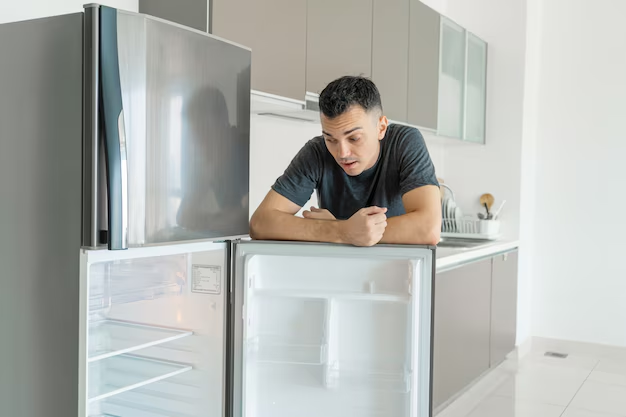Troubleshooting Your Kenmore Refrigerator: Why It’s Not Cooling and How to Reset It
There's never a good time for your refrigerator to stop working—especially when it's filled with fresh groceries ready to spoil. When your Kenmore refrigerator stops cooling, it can be frustrating and confusing. But before you rush to call a repair technician, there are several simple steps you can take to troubleshoot and possibly fix the issue yourself. This guide will walk you through understanding why your Kenmore fridge might not be cooling and how you can reset it to get things back in working order.
🧊 Common Reasons Your Kenmore Refrigerator Isn’t Cooling
Refrigerators are complex machines with many components working together to keep your food fresh. When it's not cooling, several factors might be at play. Here's a look at the most common culprits:
1. Power Supply Issues
Check the Power: Ensure that your refrigerator is plugged in properly and that there’s power at the outlet. It’s surprising how easy it is for a plug to get dislodged or for a circuit breaker to trip.
2. Thermostat Settings
Adjust the Thermostat: Sometimes, the thermostat dial can be inadvertently adjusted. Make sure it's set to the recommended temperature, generally around 37°F (3°C) for the refrigerator compartment.
3. Blocked Air Vents
Unblock the Vents: Items placed too close to the air vents can obstruct airflow, causing uneven cooling. Rearrange your items to allow free circulation of air.
4. Dirty Condenser Coils
Clean the Coils: Dusty or dirty condenser coils can hinder your refrigerator's cooling efficiency. They're typically found at the back or beneath the fridge. Regular cleaning using a vacuum or brush can improve performance.
5. Faulty Door Seals
Examine Door Seals: Worn or damaged gaskets allow cool air to escape, reducing cooling efficiency. Close the door on a piece of paper; if you can pull it out easily when closed, the gasket might need replacing.
6. Faulty Evaporator Fan
Check the Evaporator Fan: This fan circulates cool air in the fridge. If it’s not running, your appliance might not cool well, requiring inspection or replacement by a technician.
🛠️ How to Reset Your Kenmore Refrigerator
Resetting your refrigerator might resolve technical glitches causing cooling issues. Here’s a step-by-step approach to reset your Kenmore refrigerator:
Step 1: Unplug the Refrigerator
Start by unplugging the refrigerator from the power source. This clears any electronic memory and helps resolve some technical issues.
Step 2: Wait It Out
Leave the refrigerator unplugged for about ten minutes. This pause can reset the internal electronics. During this time, check the condition of your power cord and plug.
Step 3: Plug Back In
After ten minutes, plug the refrigerator back into the power source. Listen for the compressor and other sounds that indicate normal operation.
Step 4: Adjust Thermostat
Adjust the thermostat to the desired temperature settings. Remember, a mid-range setting is usually sufficient for effective cooling.
Step 5: Monitor Performance
Allow 24 hours to see if the cooling resumes. Monitor both the fridge and freezer compartments for temperature changes.
📑 Visual Troubleshooting Summary
Here are key takeaways and steps encapsulated in a simple checklist format, complete with emojis for skimmability:
- ✅ Check Power Supply: Ensure the fridge is plugged in and the outlet works.
- ✅ Adjust Thermostat: Confirm setting is at the recommended level.
- 🔄 Unblock Air Vents: Ensure no items are blocking the vents.
- 🧹 Clean Coils: Periodically clean condenser coils.
- 🧩 Inspect Door Seals: Look for gaps or tears in the gasket.
- ⚙️ Assess Evaporator Fan: Make sure it’s operational and noise-free.
- 🔄 Reset Functionality: Follow reset protocols to resolve minor glitches.
Potential Complex Issues Requiring Professional Help
While many cooling issues are DIY-friendly, some situations may necessitate professional intervention:
1. Refrigerant Leak
A refrigerant leak can cause cooling failure. This issue is rarely DIY and needs professional expertise to handle refrigerants safely.
2. Defective Compressor
If the compressor is overworked or malfunctioning, it may need replacement—a job for an experienced technician.
3. Faulty Temperature Sensor
A broken temperature sensor, or thermistor, might send incorrect readings, affecting cooling.
Practical Preventive Measures
To prevent cooling issues in the future, incorporate these simple maintenance tasks into your routine:
- Regularly Clean Coils: Dust and debris build-up significantly affects cooling efficiency.
- Keep Fridge Level: Ensure your refrigerator sits level to function properly.
- Organize Contents Efficiently: Overcrowding hinders airflow, causing uneven cooling.
- Periodic Gasket Inspection: Look for damage and replace if necessary to maintain an efficient seal.
DIY vs. Professional Repair
Understanding when to handle repairs yourself or call a professional ensures your refrigerator operates smoothly and safely. Begin with basic troubleshooting but recognize when an expert's touch is necessary.
- Small Fixes: Power issues, thermostat adjustments, and coil cleaning are easy DIY fixes.
- Complex Repairs: Leave compressor issues and refrigerant handling to professionals for safety and compliance reasons.
Insights and Final Thoughts
Dealing with a non-cooling Kenmore refrigerator can be daunting, but with these tips and steps, you can confidently approach the problem. Armed with knowledge about what to inspect, when to reset, and how to maintain your unit, you’re better prepared to keep minor issues from escalating. Always practice safety first, ensuring any DIY attempt doesn't compromise your appliance or personal safety.
In cases where home solutions aren’t enough, knowing when to call a professional can save time and prevent further damage. A well-maintained refrigerator not only ensures food safety but also improves energy efficiency, benefiting your household’s budget and environmental impact over time.
